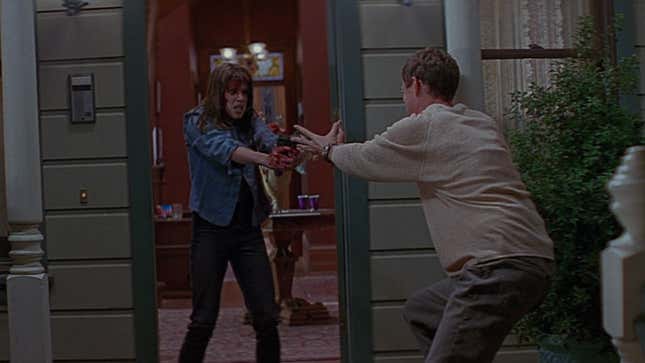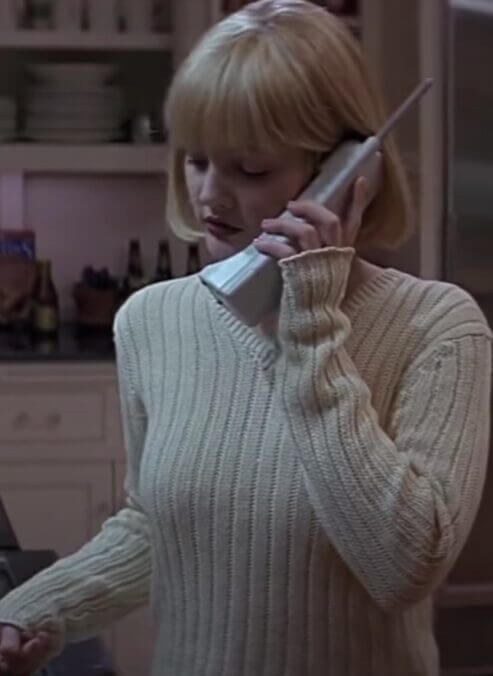Scream and the Art of Being Smart About Being Dumb
Scream is a relic of its time, but an utter standout in genre filmmaking that still holds up
EntertainmentMovies

“It’s never as good as the first time,” Sade Adu sang of love. I have rarely, if ever, found this to be true (third time’s a charm, if we’re going to generalize), but I do think it applies to the 1996 slasher movie Scream. Those of us who saw this in the theater early into its release had no idea what we were in for. Its promo campaign was vague, little more than a bunch of actors looking terrified and running and an ominous voiceover declaring, “Someone has taken their love of scary movies one step too far.” Drew Barrymore, arguably the movie’s biggest star at the time, was featured prominently. She was clearly the protagonist.
And then, 10 minutes in, after her character Casey was subjected to a sadistic game of cat and mouse over her cordless phone, she was brutally murdered and strung up on the tree in her yard. It was the single most shocking thing that I’ve ever seen in a mainstream movie. I was terrified like never before in a movie theater and rarely since. All bets were off. This movie would clearly resort to anything to fuck up its viewers. Remaining in the theater for the next 90 or so minutes was exhilarating torture.
The adrenaline rush of that opening sequence is something I wish I could experience again. Once you’re aware, the movie loses some of its visceral power. But certainly not all. Scream is a classic, up there with all of the movies its characters reference and in many cases, funnier and sharper than them. Scream is a relic of its time, but an utter standout in genre filmmaking. It inspired countless knock-offs and reinvigorated horror (slasher movies, specifically), but nothing that it gave birth to even threatened to Liza it and supersede its cultural import.

In a TV documentary included as a bonus feature in the Blu-ray set of the first three Scream films, many of those involved in the production emphasize that horror had been gutted and left for dead in the years before Scream showed its (ghost) face. The previous decade’s reliable franchises like Friday the 13th and Halloween had run out of steam, plodding along as brainlessly as the murderers they depicted. There were few truly original horror films in the early ’90s to capture mainstream attention (save the one-off brilliance of something like Candyman). The thriller had taken over. In vogue were movies with horrific elements that were either not horror films (like Basic Instinct) or that took such a radical approach to genre that they were unrecognizable as such if they qualified at all (like The Silence of the Lambs).
Wes Craven attempted to pump some new life into the slasher with his 1994 movie Wes Craven’s New Nightmare, a self-aware seventh entry in the A Nightmare on Elm Street franchise that the writer-director launched in 1984. In New Nightmare, the original film’s actors Heather Langenkamp (Nancy), Robert Englund (Freddy), and John Saxon (Nancy’s father Lt. Donald Thompson), as well as executives like New Line Cinema’s Robert Shaye, played versions of themselves, dealing with the aftermath (and future) of the franchise they helped create. It’s a movie about legends, how they never die as long as there are storytellers to repeat them, and while the acting is broad and it all devolves into another goofy Nightmare on Elm Street sequel in its third act when a new version of Freddy hunts Heather and her son, it’s at the very least a thought-provoking exercise.
It was also a flop. With a domestic gross of about $19 million, it became the lowest-grossing Nightmare, practically refuting the insistence of Shaye and Craven (who also plays himself) in the movie that the NOES audience simply would not accept the demise of Freddy Krueger (the preceding entry, the franchise’s sixth, was called Freddy’s Dead: The Final Nightmare and marketed as its last, haha). The response indicated that people, in fact, were happy to let Freddy and his series die.
these characters seemed realer to me than virtually all depictions of teens and twentysomethings I had seen so far.
Undeterred, Craven kept at horror. His next movie was 1995’s Eddie Murphy-starring A Vampire in Brooklyn. And then there was Scream. Kevin Williamson’s script circled around some of New Nightmare’s ideas, but it was fresher and infinitely funnier. If Scream didn’t position itself as canon from jump, it certainly offered its services as the genre’s ombudsman, dissecting the genre with the sick fixation of one of its antisocial antagonists. It mocked tropes while upholding them. Its cultural antecedents were certainly the movies it openly saluted, but also the pop-culture-obsessed young characters who rattled off references as a matter of course in their dialogue that were becoming commonplace in ’90s cinema (think Reality Bites and Clueless). As a pop-culture obsessive myself, these characters seemed realer to me than virtually all depictions of teens and twentysomethings I had seen so far. Pop culture is a terrific meeting ground.
It is the clash of a smirking, eye-rolling, whatEVERness and the real threat of evisceration that helps the first Scream scene retain a lot of its effectiveness, even on repeat viewings. (How many times have I watched Scream before I did this week to write about it? Twenty? Fifty? I’ve lost count, but this movie is practically fused to my DNA.) It’s a tremendous performance from Barrymore ahead of tremendous performances from just about all involved. The characters are just blank enough to stay out of the way of the plot’s momentum and rendered just specific enough to feel realer than virtually any other legion of maniac victims that we’d previously seen. Rose McGowan’s spunky Tatum has always been my favorite. Hers is an exuberant performance that is also reeled in enough to never approach hamminess (I wish I could say the same for Matthew Lillard’s turn). The commanding glow emanating from McGowan is that of a bright future, which makes the tragedy of the abuse and injustice she says she suffered that much more palpable.
Williamson’s script sparkles. His high school students fling insults and compliments (“fuck rag,” “goon fuck,” “stud bucket”) that are original but not quite as esoteric as those in Heathers, many of which were just made up to satirize the way teens talk. Without fanfare or self-congratulation, his script examined the effects of trauma on its protagonist, Sidney (Neve Campbell), who is still reeling from the rape and murder of her mother when her own stalking begins. Campbell’s sweetness and vulnerability make her third-act strength that much more satisfying.
Scream leaves nothing much to subtlety, and it comments on this aspect as well, with one antagonist declaring: ‘Movies don’t create psychos. Movies make psychos more creative.’
Sometimes Scream feels like Cliff’s Notes Carol Clover, especially in the dialogue of video-store clerk Randy (Jamie Kennedy), who gives a lesson in tropes during a viewing party of the original Halloween. But even that stuff is mostly delicious, too—meta-commentary is taken to a delirious level when, later, a drunk Randy continues watching Halloween by himself on the couch and slurs at the screen, “Jamie, look behind you!” while the Scream killer stalks him from behind. He’s talking to that movie’s protagonist, Jamie Lee Curtis, and also himself, Jamie Kennedy. Amazing trick. Scream’s killers, revealed in a series of twists, are similarly savvy with genre tropes, and the movie is clearly commenting on societal anxiety of the corrosive effect that watching scary movies will have on young, impressionable audience members. This is a satirical vision of a worst-case scenario that is also consistently terrifying in its potential realism. But Scream leaves nothing much to subtlety, and it comments on this aspect as well, with one antagonist declaring: “Movies don’t create psychos. Movies make psychos more creative.” Touché. Scream shows and tells.
Maybe what I love most about Scream is that when all the smarty-pantsing is said and done, it’s all just been an excuse for another dumb bloodbath. The movie represents progress in motion and is more creative than so much that happened in the time between its grandfather Halloween and it, but it’s still just another scary movie, another excuse for a franchise. (Williamson had already outlined his trilogy when he started shopping his script, hoping to woo investors with series potential.) Scream knew its place, the ultimate sign that it deeply understood what it was talking about.
I realize that it’s a bit strange to write effusively about a Harvey Weinstein property in 2020. Scream’s distributor, Dimension Films, was Miramax’s genre label. What do we do with movies that were important and influential and fucking brilliant that also had attached to them, men who have been accused of heinous, career-destroying, life-upending crimes? I don’t know that there is a single answer to this, and avoiding them entirely seems a completely reasonable course of action. As a great admirer of ’90s cinema, I just can’t do that with a lot of the films that Weinstein worked on. I don’t want to live a life without Pulp Fiction or Jackie Brown or Madonna: Truth or Dare or Unzipped or Paris Is Burning or Scream. Still, I thought it would be useful to call on some guidance, so I read the section of Rose McGowan’s 2018 memoir Brave about the filming of Scream. At the time, McGowan hadn’t yet met Weinstein, which she says happened at the 1997 Sundance Film Festival (during which she also says he raped her). In Brave, McGowan calls Scream “a refuge for me” and offers a rather cogent assessment of its artistic success:
No one discusses how disconnected people are when they watch horror films. God forbid you watch someone die awfully and you feel something. If you don’t think this translates to real-life numbness, you’re deluding yourself. Numbing yourself to violence against women comes early and if it’s not coming to you at your home, and I hope it’s not, then it’s coming to you through TV and film. What I thought the original Scream did very well was to make you care about each character. We weren’t disposable.
Amen.